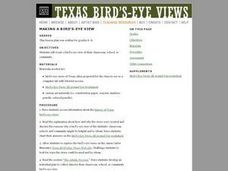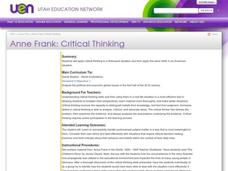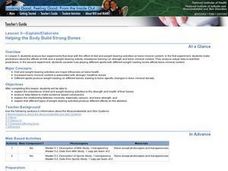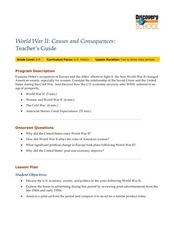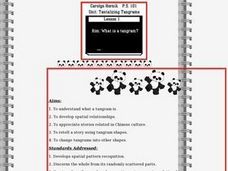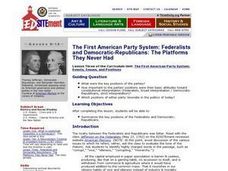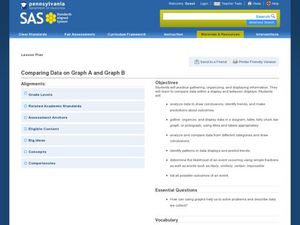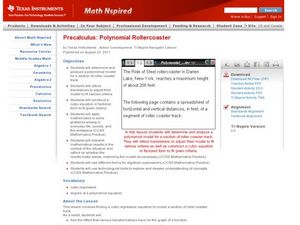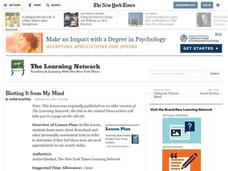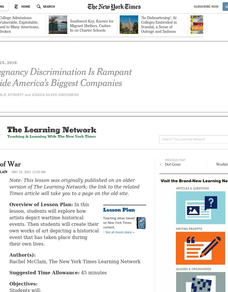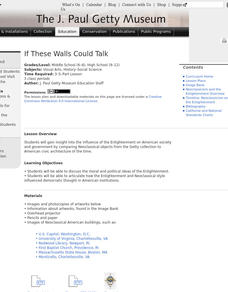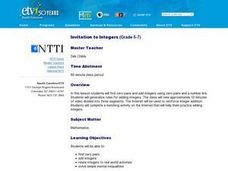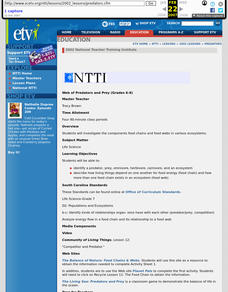National Endowment for the Humanities
"Old Southwest" Humorists and George Washington Harris
Young scholars discover the work of George Washington Harris and his influence on American humor. For this George Washington Harris lesson, discuss cultural differences in the United States and read Sut Lovongwood stories by George...
Curated OER
Debate: Is Cheerleading a Sport?
Students research how women are perceived in sports. They debate the issue of whether cheer leading should be considered a sport and are scored on student made rubrics.
Curated OER
EXCEL It!
Young scholars surf the Web gathering information about graphs. The data collected is incorporated into an Excel spreadsheet and graphs of varying nature generated to further enhance student understanding.
Curated OER
Making a Bird's Eye-View
Students explore the bird's-eye views on the Texas Bird's-Eye Views website, and discuss why the views were created. They design and create a bird's-eye view of their classroom, school, or community.
Curated OER
Anne Frank: Critical Thinking
Students read a story by James Clavell about propaganda and they discuss how it was used in the story. In groups, they decide what they would do if faced with certain situations.
Curated OER
Helping the Body Build Strong Bones
Students explore the effects of diet and weight-bearing activities on bone mineral content. The influence of playing a variety of sports with different weight-loading levels is examined.
Curated OER
Health Outreach -- Creating Research -- Based on Pamphlets on STDs
High schoolers view a video clip about people affected by STDs. They research causes, symptoms and cures of a sexually transmitted disease of their choice. They create a pamphlet to share information.
Curated OER
"Jazz is About Collaboration": Jim Crow Laws And Segregation
Students explore development of jazz music in the 1930s by forming imaginary jazz bands which tour several cities in Depression-era America. Jazz band members create imaginary identities for themselves, develop publicity for their tour,...
Curated OER
World War II: Causes And Consequences
Middle schoolers discuss the U.S. economy, society, and politics in the years following World War II. They explore the boom in advertising during this period by reviewing print advertisements from the late 1940s and early 1950s. ...
Curated OER
Charts, Maps, and Graphs Lesson on the Holocaust
High schoolers practice interpreting data. In this Holocaust instructional activity, students research selected Internet sources and examine charts, maps, and graphs regarding the Jewish populations in and out of Europe. High schoolers...
Curated OER
What is a Tangram?
Students identify a tangram. In this geometry lesson, students read Grandfather Tang's Story and retell each story using the tangrams on a flannel board. Students use tangrams to complete an included worksheet.
Curated OER
Writing Folktales
Students consider the structure of folktales. In this writing skills lesson plan, students list the attributes of folktales that they read in class. Students then complete handouts based on the elements of the tales as well as types of...
Curated OER
The First American Party System: Federalists and Democratic-Republicans: The Platforms They Never Had
Students investigate the beginnings of the political party system in the US. They determine the key positions of both the Federalists and the Democratic-Republicans. They compare the views of the early political parties with those of today.
Curated OER
Comparing Data on Graph A and Graph B
Second graders gather and graph data. For this graphing lesson, 2nd graders collect data and graph this information using tally charts, bar graphs, pictographs, or tables. They make predictions about the outcomes.
Curated OER
Polynomial Rollercoaster
Learners relate polynomials to a rollercoaster track as they translate a graph around on a coordinate plane. They differentiate between different forms of algebraic expressions.
Curated OER
Psychology: Blotting It from My Mind
Students research Rorschach and other personality assessment tests in order to determine if they feel these tests are used appropriately in our society today.
Curated OER
Masters of War
Young scholars explore how artists depict wartime historical events. Then students create their own works of art depicting a historical event that has taken place during their own lives. They create a classroom gallery.
Curated OER
Classroom and Laboratory Management Pre Assessment
Students will learn the meaning of food science and management for the classroom and laboratory. Background For Teachers: NOTE TO TEACHERS: A pre-assessment should never be graded. Good pre-assessment devices, however, can also be used...
Curated OER
Crossroads Blues
The crossroads, and the decisions made and entities met there, are a common theme in literature, pushing readers to examine the choices and encounters that shape life experience. The theme has also been explored in blues music, most...
Curated OER
Pharaoh Phonetics
Learners explain the purpose of hieroglyphics and identify their role in communicating ideas. They research the history of writing and it's significance in ancient Egyptian life and identify the components of hieroglyphics.
Curated OER
If These Walls Could Talk
Students compare Neoclassical objects from the Getty collection to American civic architecture of the time. They discuss the moral and political ideas of the Enlightenment and articulate how these art forms influenced democratic thought...
Curated OER
A Dream Of Classic Perfection
Students examine primary sources in order to draw conclusions about the influence of Greek classical art and philosophy on the French Revolution. They compare the goals of the French Revolution to those of Neoclassical artists.
Curated OER
Invitation To Integers
Students find zero pairs and add integers using zero pairs and a number line. They generalize rules for adding integers. The class view approximately 10 minutes of video divided into three segments.
Curated OER
Web of Predators and Prey
Students investigate the components food chains and food webs in various ecosystems. They describe how living things depend on one another for food energy (food chain) and how more than one food chain exists in an ecosystem



